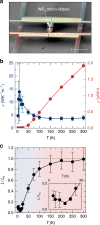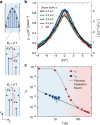Thermal and electrical signatures of a hydrodynamic electron fluid in tungsten diphosphide
- PMID: 30291248
- PMCID: PMC6173759
- DOI: 10.1038/s41467-018-06688-y
Thermal and electrical signatures of a hydrodynamic electron fluid in tungsten diphosphide
Abstract
In stark contrast to ordinary metals, in materials in which electrons strongly interact with each other or with phonons, electron transport is thought to resemble the flow of viscous fluids. Despite their differences, it is predicted that transport in both conventional and correlated materials is fundamentally limited by the uncertainty principle applied to energy dissipation. Here we report the observation of experimental signatures of hydrodynamic electron flow in the Weyl semimetal tungsten diphosphide. Using thermal and magneto-electric transport experiments, we find indications of the transition from a conventional metallic state at higher temperatures to a hydrodynamic electron fluid below 20 K. The hydrodynamic regime is characterized by a viscosity-induced dependence of the electrical resistivity on the sample width and by a strong violation of the Wiedemann-Franz law. Following the uncertainty principle, both electrical and thermal transport are bound by the quantum indeterminacy, independent of the underlying transport regime.
Conflict of interest statement
The authors declare no competing interests.
Figures



References
-
- Hartnoll, S. A., Lucas, A. & Sachdev, S. Holographic quantum matter. Preprint at https://arxiv.org/abs/1612.07324 (2016).
-
- Hartnoll SA. Theory of universal incoherent metallic transport. Nat. Phys. 2015;11:54–61. doi: 10.1038/nphys3174. - DOI
-
- Lucas A, Crossno J, Fong KC, Kim P, Sachdev S. Transport in inhomogeneous quantum critical fluids and in the Dirac fluid in graphene. Phys. Rev. B. 2016;93:075426. doi: 10.1103/PhysRevB.93.075426. - DOI
Publication types
LinkOut - more resources
Full Text Sources

